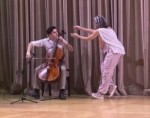
A Cross-species Movement Dialogue Between Agency and Vulnerability
by Caitlin Green
“Que vidas tienen valor?” is projected high onto the studio wall with bold letters scrolling back and forth overlooking a giant inflatable pig. “Whose lives count as lives?” From the time we enter the room the audience is prompted to examine the concept of worthiness – a charged subject, especially considering the contemporary cultural and political climates we navigate, where one’s autonomy and privilege can be determined by gender, race, class, religion and other facets of identity that are prioritized based on hierarchies of power. Attention is frequently redirected from the human subject to livestock and the natural world. Dancers often mimic their porcine counterparts though the piece emphasizes a distance between the two. Later, the walls host a new phrase declaring that “humans will be reconciled with their animal nature.”
Silvana Cardell’s multidisciplinary work, Disposable Bodies features sound design by Maria Chavez, sculptures by Daniel Cardell & Paula Meninato, film projection from Christopher Ash & Colin Sass, and Blanka Zizka as dramaturge. The choreography sends the dancers of Cardell Dance Theatre (Mackenzie Morris, Ama Ma’at G. Oyesii, Tyler Rivera, William Robinson, Muyu Yuan Ruba, Merian Soto) through an embodied dialogue between agency and vulnerability, expressed by their use of weight, and one another. Like a mosh pit, they use their bodies to push against, collapse onto, and spring off of each other, gaining momentum in the process. Weight sharing, baring, and exchange drew me to question vulnerability as a choice versus a sacrifice. Who is carrying the weight, who is being uplifted? How much weight does identity carry in determining these roles? “Whose lives count as lives?”
A sonic blend of factory noises and snorting, grunting livestock occupies the aural atmosphere as an image of a caged hog appears in the film. The focus narrows in on the eye of the animal – its most human feature. Is this a plea for compassion? Performer Merian Soto follows her prey onto the stage. A butcher knife accessorizes each hand as she takes looming strides toward the “animal”. The subject is an anonymous bare-backed dancer traveling forward on all fours. Their clothing wrapped around their head deems them faceless; they mimic a hog – maybe a disposable human? In a reversal of roles, the butcher woman is stripped naked and captured in a long, sheer plastic material then removed from the stage after a struggle for resistance.
Later, the ensemble clutter together in a desperate and frantic collision: wrestling, bumping against, and collapsing into one another. Occasionally, a single body manages to ascend above the rest, using the momentum from the others in the scramble. This exhaustive and feral tussle ultimately leads to the destruction of the enormous inflatable centerpiece - a pig which is annihilated in the chaos. One dancer (Morris), now limp and nude, becomes a canvas for the word “animal” scribbled on the body in black sharpie. There is a clear contemplation of power, both between human and animal, and across human identities that ponders the question “Vidas protegidas o vidas abandonado?” (Protected or abandoned lives?)
There were moments of reprieve from the images of death and human/animal cruelty throughout the piece. These scenes were serene and ethereal and created a sense of calm and wonder. Dancers mirrored the visuals of ocean waves crashing against rocks that were projected in the background. Exploding into lifted extensions, their limbs were free and expansive. I couldn’t tell if these moments were solely for the sake of the audience or if they held a sequential role in the narrative. I wanted to know more.
In a final utopia, dancers are dressed as gods and goddesses with sheer white material wrapped around their bodies like togas, creating a dream-state. Like amoeba, they expand and coil, reaching and recuperating into themselves with sustainment as their solos bring them closer to one another. They take their time over the ambient sound that captures the softness of the scene, and begin to connect. Two dancers carry Ama Ma’at G. Oyesii, who leisurely rests on their backs, taking occasional bites from an apple. This is a regal scene, a moment of glory that sticks in my mind after I leave the studio, representing the delicacy and honor that Black women and femmes don’t experience often enough. Oyesii crouches to drink water from a bowl offered by the fellowship surrounding them. Nourished, they then crawl inside of a large boar made of wire and are dragged by the ensemble who roll the material away. The imagery resembles a conveyor belt on shiny metallic paper. Oyesii suddenly rises from within the animal, and walks free of the disappearing foundation, then runs free of the animal too. The silver wired pig remains onstage and I reflect on an earlier quote from the work: “The disappearance of humans is not a catastrophe. The natural world remains what it has been”.
Disposable Bodies, Cardell Dance Theatre, Taller Puertorriqueno, Oct. 27-30.
This article has been updated on 11/27/22. It has been corrected to include the full dates of the performance and to include the names of all the performers and dramaturge Blanka Zizka.
By Caitlin Green
November 27, 2022









